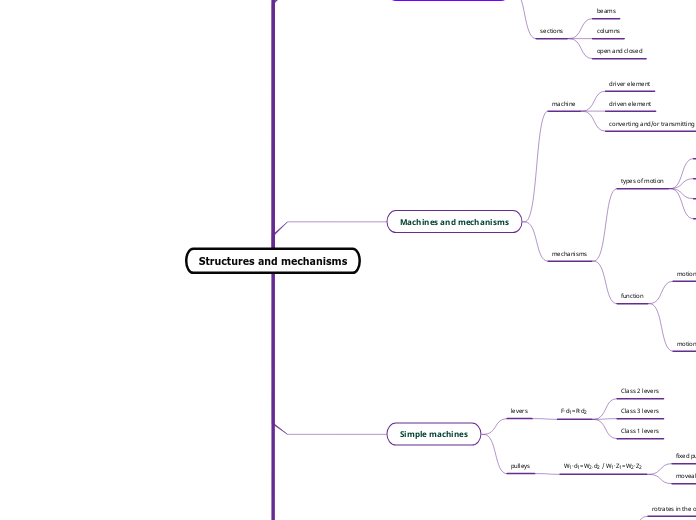Structures and mechanisms
Structure
types
Mass
Suspended
Truss
Frame
Forces,stresses and strength
force
stress
strong
Types of stress
Compression
tension/traction
bending
torsion
shear
Conditions for strong structures
rigidity
rigid, no deformable
equilibrium
equilibrium
stability
stable
Strengthening elements
strong
depends on
types of forces applied
shape of the stucture
obtain
making more stable
making more rigid
Increase stability
stable
center of gravity
increase rigidity.Trusses
trussing
thanks to the triangle
diagomal bar
a brace
stay cables
sections
beams
columns
open and closed
Machines and mechanisms
machine
driver element
driven element
converting and/or transmitting element
mechanisms
types of motion
linear motion
rotary motion
reciprocating motion
oscillating motion
function
motion transmission
liner transmission
levers
pulleys
rotary transmission
gears
friction wheels
motion conversion
cams
screw and pinion
Simple machines
levers
F·d1=R·d2
Class 2 levers
Class 3 levers
Class 1 levers
pulleys
W1·d1=W2·d2 / W1·Z1=W2·Z2
fixed puelleys
moveable puelleys
Rotary transmission mechanisms
friction wheels
rotrates in the opposite direction
can slip
can be subject to wear and tear
belt and pulley system
Subtopic
Subtopic
gears
large power transmission
a lot of friction
noisy
chain and sprocket system
don't slip
need greasing
noisy
worm gear
speed producer
compact and quiet
isn't reversible
Motion conversion mechanisms
screw and nut
a good speed reducer
reversible
rack and pinion
smooth and precise
reversible
ceank and slider
reversible
cams
convert rotary motion into
linear reciprocating motion
eccentric cam
Other mechanisms
wedge
ramp
ratchet
Leaonardo da Vinci
the first technological designer
worm gear
screw and nut mechaism
different gears
